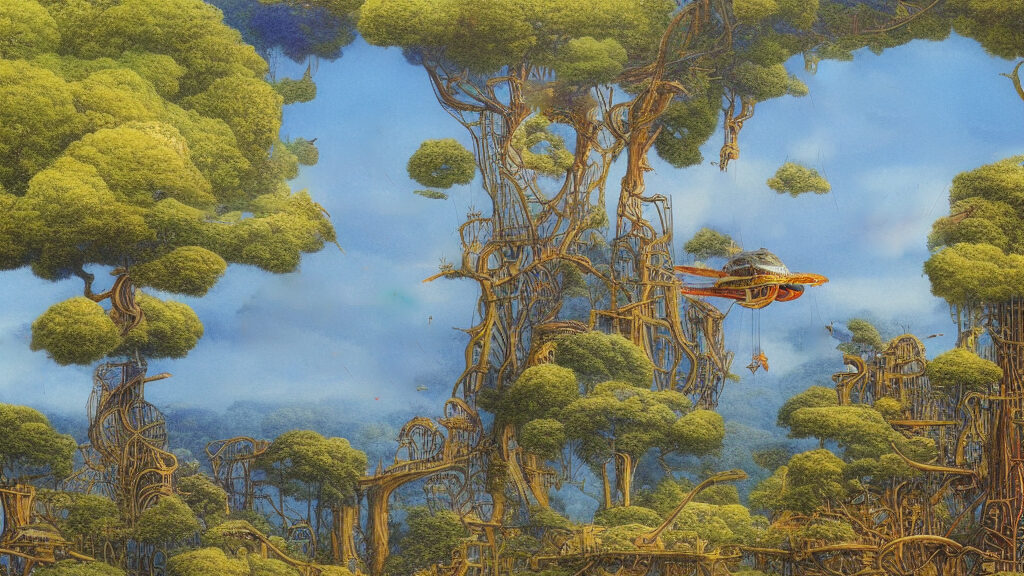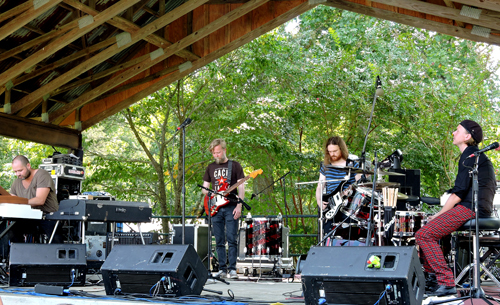
The eagerly anticipated second act on Sunday at ProgDay 2014 was the relatively new Swedish progressive rock band Necromonkey. This group features two essential musicians in the Swedish progressive music scene, former Anglagard drummer and keyboardist Mattias Olsson; and Gosta Berlings Saga’s keyboardist David Lundberg.
Indeed, Necromonkey was one of the highlights of ProgDay 2014. The lineup at ProgDay featured David Lundberg on Fender Rhodes electric piano, Minimoog, Mellotron, and Taurus pedals; Mattias Olsson on drums, percussion, Mellotron and Moog synthesizer; Einar Baldursson on guitar; and Kristian Holmgren on bass.
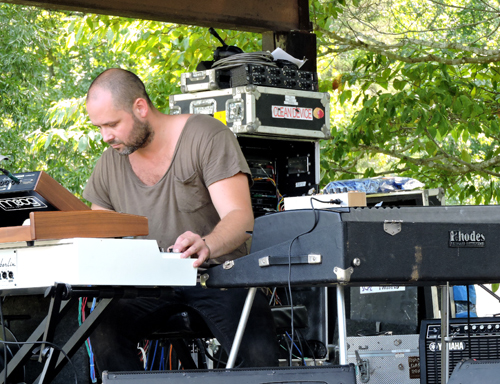
Necromonkey played outstanding pieces from the first two albums, Necroplex (2010) and A Glimpse of Possible Endings (2014) that were rearranged and changed with new parts. The band also played material from the forthcoming albums three and four. It was a collection of mesmerizing compositions that crossed various musical boundaries, ranging from electronic explorations to classic epic progressive rock. Necromonkey demonstrated that they are the vanguard of Swedish progressive music, pushing the boundaries of progressive rock in all the right ways.
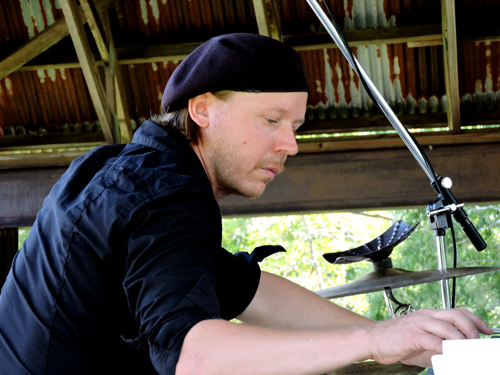
Mattias Olsson discusses the band’s musical history with Progressive Rock Central.
Can you give our readers a brief history on how the band was formed?
MO: We met during the recording of Gösta Berlings Saga’s second album Detta har hänt when the band contacted me about recording a plethora of vintage keyboards. David and I found a connection and then on my 35th birthday we decided to record an album together. The next morning I told him the band was gonna be called Necromonkey. After that things happened very quickly.
What do you consider as the essential elements of your music?
MO: As David is primarily a keyboard player and I am primarily a drummer that is usually where the songs start. But there are no real boundaries for how the songs evolve and change. Both David and I play guitar as well but are both suckers for rhythm as well.
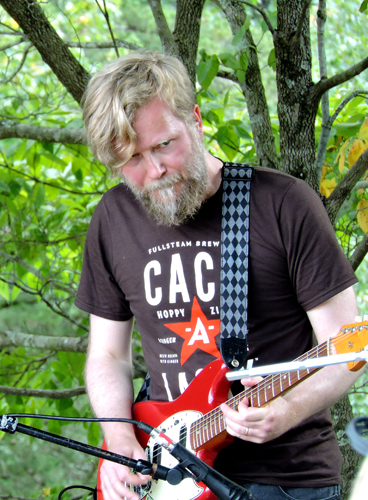
Who can you cite as your main musical influences?
MO: David is a lifelong subscriber to Magma fandom but can equally rave about a Katy Perry song on the radio or Rage against the Machine. It varies a lot. My main influences range from Kraftwerk and Can to Radiohead and Sigur Ros passing Harry Partch and Korla Pandit on the way. We both are fans of Tortoise and Battles.
Tell us about your first recordings and your musical evolution.
MO: For us the evolution isn’t all that linear. The first album was done fairly fast and was a lot about breaking rules and pushing our boundaries. See what we were. The second was better organized as we had the first album to kind of push from. The new albums are very varied ranging from symphonic pieces to electronic stuff and “traditional” prog.
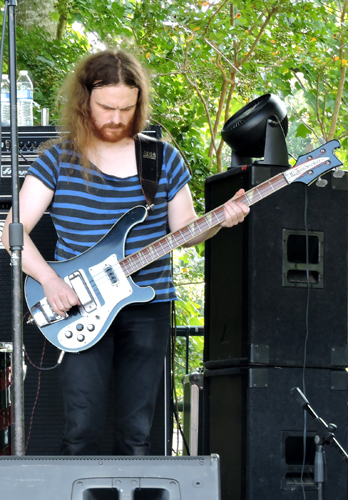
How’s the current progressive rock scene in Sweden?
MO: I would say that there is a lot of movement in the whole neo prog scene. Necromonkey and Gösta Berlings saga are undeniably linked and probably cross over more than a lot of prog bands which is wonderful. I think we are outsiders in a way. We played the Swedish progfest which was great.
What musical instruments do you use?
MO: David’s main instrument is the Fender Rhodes and a lot of ideas start there and then sort of crop out into other instruments such as the grand piano, Celeste or Wurlitzer. We try to extend our ideas sonically. I own a studio where we have access to an impossible array of instruments like bass marimbas, church organs and purpose built instruments. One of our favorite instruments is of course the Mellotron. We have four Mellotrons in the studio and two chamberlins so they have a tendency of being used a lot. We also love the sound of old optical organs like the Orchestron and the Optigan.
Also we use an old Modular synth a lot for treatments and bass lines….and then the VCS3….and the baritone guitars…the list goes on and on….
What effects do you use?
MO: Both David and I are pedal junkies so we use a lot of old guitar pedals and stomp boxes and we are constantly searching for new exciting sounds and combinations. We have over 100 pedals and we are always on the hunt for more.
We also use the Modular system for filters and effects. Our main reverb is a very big AKG spring reverb.
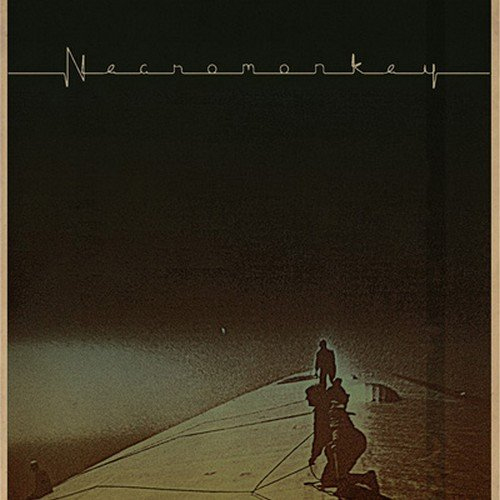
If you could gather any musicians or musical groups to collaborate with, who would that be?
MO: We are always interested in collaborations and we have worked closely with visual artist Kjahart. It would be great to work with a percussion ensemble at some point. We use a lot of mallet instruments on the recordings so it would make sense to do more of that.
We aren’t that keen on collaborations with “heroes” or anything like that as we feel that it often overshadows the music. We would rather highlight younger artists on the rise as they are often hungrier and more exciting.
Do you have any upcoming projects to share with us?
MO: We just got back home from the US but will start working on finishing album number 3 as soon as possible. We are also discussing doing maybe one or two bootleg releases from the last US tour depending on how the recordings turned out. After that we will probably be doing a live in the studio album in front of a live studio audience to capture where we are right now.
We have three or four albums of unreleased studio material that we are waiting to unleash. It’s a very exciting period in the band’s life.
We are also discussing extensive tour plans for 2015 with a return to the US with a West Coast run this spring and then an East Coast next fall.
